Radish is a healthy and affordable vegetable that has anti-inflammatory, antibacterial, antimicrobial, immunomodulatory and fat-burning effects. The latter property is widely used by nutritionists when preparing diets for weight loss. Radish for weight loss is also useful because, along with burning excess fat, it saturates the body with vitamins and minerals, and also helps cleanse and normalize the functioning of the gastrointestinal tract, liver and kidneys. This is a prerequisite for effective weight loss.
Composition and beneficial properties
Radish is an annual herbaceous plant of the cabbage family.
Depending on the variety, the root vegetable can have a round or oblong shape, and the color of the skin can be black, green or white. Root vegetables (raw, fried and boiled), as well as young foliage, are eaten. They are added to soups, borscht, salads, snacks, meat and vegetable dishes. Radish effectively replenishes the lack of vitamins and minerals in the autumn-winter period. The list of useful substances contained in the root vegetable is long. This includes salts:
- sodium;
- calcium;
- potassium;
- magnesium;
- gland;
- phosphorus.
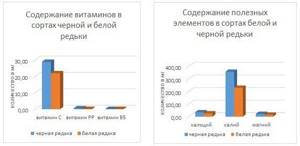
In addition to salts, radish roots are rich in:
- amino acids;
- fiber, which improves digestion;
- sulfur-containing substances;
- essential oils;
- enzymes;
- organic acids;
- glucosides;
- vitamins of group B and C.
Due to the wide range of beneficial substances of the root vegetable, traditional medicine recommends using the food in the treatment of diseases such as:
- cholelithiasis and urolithiasis;
- chronic constipation;
- flatulence;
- anemia;
- rheumatism;
- dysfunction of the gastrointestinal tract;
- gastrointestinal atony;
- atherosclerosis;
- cholecystitis;
- bronchitis;
- whooping cough;
- catarrh of the respiratory tract;
- neuralgia.
Compresses prepared with radish effectively relieve rheumatic joint pain. Radish has anthelmintic and lactic properties. In cosmetology, the root vegetable is used to stimulate hair growth, and in dietetics – as an effective means for losing weight.
Eating dishes with root vegetables for weight loss:
- helps remove excess fluid from the body;
- prevents fat accumulation;
- creates a feeling of fullness for a long time due to the increased fiber content;
- improves metabolism and helps improve digestion, which is an integral part of effective weight loss;
- saturates the body with vitamins, minerals and other beneficial substances, preventing a decrease in their amount in the body during the process of losing weight.
What are the benefits of radish? To answer this question, you should consider the composition of this product. Radish contains vitamins C, B1, B2, essential oils and enzymes. In its root vegetables you can find up to 90% water, 2% protein, 8% carbohydrates. Here you will find such important elements as: magnesium, calcium, iron, phosphorus.
In folk medicine, there are many medicinal products and preparations that are prepared on the basis of radish. These remedies can be used in the following situations:
- To treat radiculitis, raw grated radish and its juice are used;
- the beneficial properties of radish can be felt during the treatment of various intestinal diseases;
- to improve the emptying of the gallbladder and remove excess fluid from the body;
- for the treatment and prevention of diseases of the digestive system;
- for colds, the product is especially good at helping to get rid of cough;
- for anemia and neuralgia;
- for wound healing;
- to strengthen hair.
If you are still wondering whether radish is healthy, you can carefully study the full chemical composition of the product, and then all doubts will disappear by themselves. About 2 g of protein, 6.7 g of carbohydrates and only 0.2 g of fat - isn't this the ideal diet?
What is the value of vegetables for losing weight?
Radish is useful because it contains a large amount of biologically active substances, minerals and vitamins. The constituent components of the root vegetable are easily absorbed by the body. Proteins, sugars, enzymes and organic acids are quickly broken down and accelerate the metabolic process in the body, which is very important in the process of burning fat.
For weight loss, you can use green and black radish. Both products have the same properties. Another advantage is that this is a relatively inexpensive vegetable, so such a diet will not be expensive.
Radish: contraindications
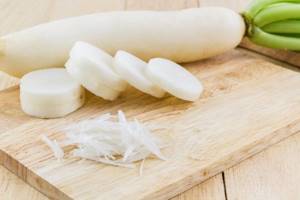
Radish of all types has a pronounced pungency and a bitter specific taste. For this reason, consuming it in large quantities is difficult and unsafe, since even in a healthy person this product can cause irritation of the mucous membranes of internal organs. Contraindications to the use of radish are diseases and conditions such as:
- ulcers and gastritis, especially in the acute stage;
- increased stomach acidity;
- tendency to heartburn;
- obstruction of the biliary tract;
- severe liver and kidney diseases;
- inflammation of the rectum (anal fissures, hemorrhoids);
- severe cardiovascular diseases;
- mouth and throat ulcers;
- tendency to allergic reactions;
- tendency to form Quincke's edema;
- pregnancy.
In cases where there are contraindications or root vegetables are consumed in too large quantities, side effects can be caused such as:
- exacerbation of chronic diseases;
- heaviness and bloating;
- increased acidity of gastric juice;
- flatulence;
- irritation of the mucous membranes of the oral cavity and gastrointestinal tract;
- premature birth.
Despite the obvious benefits of Japanese radish for health, beauty and effective weight loss, one cannot help but warn about possible risks.
Firstly, it is contraindicated for people with diseases such as:
- gastritis;
- stomach and duodenal ulcers;
- gout.
Secondly, before including this vegetable in the diet, it is necessary to consult a doctor for those who have:
- diseases associated with metabolic disorders;
- chronic liver and kidney diseases;
- osteochondrosis.
And thirdly, excessive passion for this root vegetable can cause flatulence. Not only the gradual inclusion of this product in the menu will help you avoid troubles, but also the serving size: no more than 60-150 g per day.
In conclusion, here is an interesting fact. Despite the fact that Japanese radish has been grown in the land of the rising sun for over a thousand years, it is still the most popular vegetable crop there. Moreover, the crop fields occupied by this root crop are growing every year, and it is given an honorable first place among other vegetables.
It becomes clear why the Japanese include this wonderful vegetable in their food menu as often as Russians include potatoes. But the daikon radish promotes effective weight loss better than the starchy earthen apple, beloved in Russia. We invite you to pay attention to this miraculous root vegetable, and you will provide yourself with a boost of health for many years, and beauty and a slender, fit figure will become your constant companions.
Radish contraindications are minor, but they are worth mentioning so that you know what to do in a given situation. In the following cases, eating this product is strictly prohibited:
- stomach ulcer;
- gout;
- inflammatory processes requiring surgical intervention.
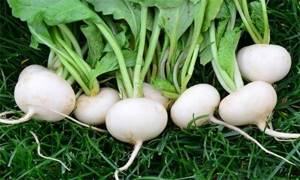
There are also certain diseases during which you will have to limit the amount of product consumed per day. For example, in case of severe heart and kidney diseases, it is worth reducing the consumed amount to a minimum.
In all other cases, you should not expect harm from radish, because it is a valuable and useful product that can cure you of many diseases.
Are there any diets based on this root vegetable?
There is no mono-diet on daikon. But there are diets that include this root vegetable and are distinguished by a wide variety of products, that is, the menu is hearty and varied.
The five-day diet allows you to eat rice, fish, vegetables (including daikon), and fruits.
- breakfast: rice and salad with daikon;
- snack: fruit;
- lunch: fish soup, baked fish with vegetables;
- afternoon snack: fruit;
- dinner: fish and salad with root vegetables.
Salads can be different, there are quite a lot of recipes. Daikon goes best with carrots, cucumbers and tomatoes, herbs, and boiled eggs.
Another diet, designed for 10 days, suggests drinking juice from root vegetables. Freshly squeezed juice can be drunk only two tablespoons on an empty stomach. You cannot drink the drink in larger quantities. In addition, you can eat lean meat and fish, fruits, vegetables, cereals, cottage cheese and kefir.
Here is a sample diet menu:
- in the morning: juice, then porridge or boiled eggs, fruit;
- second breakfast: berries or fruits;
- lunch: vegetable soup, a piece of meat and salad, compote;
- afternoon snack: vegetable salad;
- dinner: fish and vegetables or cottage cheese casserole, tea;
- before bed: kefir.
If you don’t really like juice, you can drink green smoothies made from cucumber, parsley and daikon or mango and radish. These drinks promote rapid fat burning. It is best to consume them before physical activity or training. That is, if you have not exercised before, you will have to take up swimming, walking, running, gymnastics or fitness. Exercising together with proper nutrition and healthy cocktails will help you get pretty good results in a short time.
Which radish to choose?
The choice of radish for weight loss is a matter of individual preference, since all types of root vegetables are approximately the same in composition and effect on the body, but differ in their taste: black radish is the hottest and most bitter, daikon is the softest and most pleasant to the taste. When choosing a variety of root vegetable, you can refer to the advice of Japanese nutritionists, who recommend including daikon dishes in your diet on a regular basis starting from the age of 25. This will help maintain health, slimness and youth for many years.
Only ripe and high-quality root vegetables should be eaten. In order not to make a mistake when choosing a radish, you need to pay attention to:
- on appearance (the vegetable must be smooth, without flaws or wormholes);
- on color (it should be even and rich);
- for density (fresh root vegetables are hard to the touch);
- on the condition of the tops (they should not be limp).
Green radish
Green radish is a product of selection that is not found in nature. In composition, this type of root vegetable is close to black radish, and in taste it is something between radish and daikon (white Japanese radish) and leaves a soft, slightly bitter aftertaste on the tongue. The root vegetable has an oval shape, the skin at the base is dark green, and the tip is white. The flesh of this radish is light green in color.
The root vegetable contains useful substances such as:
- vitamin A, essential for healthy skin and eyes;
- B vitamins, including pyridoxine, riboflavin, thiamine, necessary for the normal functioning of the nervous and endocrine systems, as well as metabolic processes and skin regeneration;
- nicotinic acid, which is necessary for the normal functioning of metabolic processes at the cellular level and is an important structural element of hair and skin;
- salts of phosphorus, sulfur, sodium, potassium, calcium, iron;
- cellulose;
- amino acids;
- essential oils;
- fatty acid.
An important advantage of green radish is its low calorie content: 100 g of pulp contains only 9 kcal, due to which the root vegetable is widely used in the preparation of dietary dishes for people who want to lose weight.
Eating green radish pulp is useful for normalizing:
- intestinal peristalsis;
- cholesterol levels;
- sugar level;
- blood pressure;
- functioning of the liver and gall bladder, since it has a powerful choleretic effect.
Green radish is useful for the prevention of atherosclerosis and other cardiovascular diseases. Possessing a bactericidal effect, it is indispensable in the treatment of infectious and inflammatory diseases of the gastrointestinal tract and upper respiratory tract, treatment of suppuration and long-term non-healing wounds. The pulp of the root vegetable is used to prepare compresses for the treatment of radiculitis, bruises, and dislocations.
The beneficial substances that make up green radish help eliminate toxins, waste and other toxic substances that actively accumulate in the body, especially in cases of unbalanced nutrition and excess weight.
Black radish
Black radish is the most bitter and the healthiest of all varieties. It contains:
- carotene;
- retinol;
- vitamins B9, C and K;
- organic fats;
- fructose;
- amino acids;
- enzymes;
- phytoncides;
- proteins and essential oils;
- microelements such as iron, phosphorus, zinc, sodium, magnesium, etc.
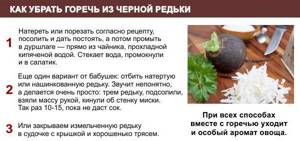
The calorie content of the root vegetable does not exceed 35 kcal per 100 g. Black radish has the following effects on the body:
- increases immunity;
- removes excess fluid from the body;
- normalizes digestion;
- improves blood circulation;
- dissolves waste accumulated in the gall bladder and ducts, renal pelvis, bladder and blood vessels;
- liquefies and removes viscous secretions from the bronchi in patients with bronchitis, promoting rapid recovery.
White radish
White radish (daikon) resembles carrots in appearance. Its root crops can reach a weight of 2 kg. The vegetable tastes more like a radish, but is even softer and more tender. To maintain slimness and improve health, daikon is best consumed raw.
The caloric content of root vegetables does not exceed 20 kcal per 100 g. It contains such useful substances as:
- vitamins of groups B and C;
- trace elements: potassium, sodium, manganese, chromium, selenium, iodine;
- folic acid;
- thiamine;
- niacin;
- biotin;
- pectin;
- beta-carotene;
- specific protein compounds;
- phytoncides.
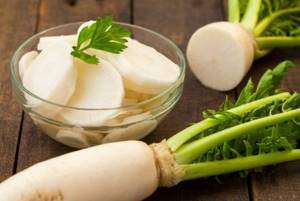
Unlike other varieties of root vegetables, daikon has a much wider range of positive effects on the human body, including:
- improving food absorption;
- purgation;
- an increase in the number of beneficial bacteria in the intestines;
- blocking the spread of pathogenic microflora;
- acceleration of the breakdown of starch and carbohydrates;
- eliminating the feeling of hunger;
- normalization of the cell building process;
- removal of excess fluid;
- removal of sand from the kidneys and gall bladder;
- dissolution of small cameos;
- acceleration of the wound healing process;
- acne elimination;
- strengthening the immune system;
- mild skin whitening (pigment spots, freckles);
- improvement of metabolism;
- strengthening the nervous system;
- increased brain activity;
- improved concentration;
- strengthening bones, teeth, nails, hair;
- preventing the development of malignant neoplasms;
- cleansing the lungs and improving their function;
- slowing down the aging process;
- improving the overall tone of the body.
The low calorie content of the product, combined with an extensive list of positive effects on many organs and systems of the body, have made daikon one of the most important components of dietary nutrition for weight loss.
Harm
Gastritis or ulcers. Individual intolerance. Increases stomach acidity. Promotes flatulence. It may be contraindicated in diseases of the kidneys and pancreas.
Since radish belongs to the Cabbage family, the same contraindications apply to it as for “Cabbage” .

Radish for weight loss: recipes for delicious dietary dishes
A distinctive feature of this root vegetable is its low calorie content (only 21 kcal), as well as a large amount of easily digestible protein, a complete absence of fats and the presence of active enzymes that promote the rapid absorption of starchy foods. It is also rich in healthy fiber, which, like a soft brush, cleanses the body of deposits of harmful substances, which generally activates metabolic processes and promotes effective weight loss.
If we talk about mono-diets, where the main food product will be this root vegetable, then today they simply do not exist. The reason lies in the fact that it cannot be eaten in large quantities. However, the miracle vegetable can be easily adapted to almost any dietary system. Here are some examples:
- If you have chosen effective weight loss using one of the oriental diets, where the menu will be based on rice and boiled, baked or steamed fish, as well as vegetable salads, you can diversify your diet by including daikon radish.
- This miracle vegetable is one of the most valuable in the “Kremlin diet”. It can be consumed raw, or added to soup instead of potatoes, steamed, baked or stewed.
- In a separate nutrition system, Japanese radish diversifies the range of vegetable crops used and can be used as one of the ingredients not only in salads, but also in soups and vegetable-based main courses. In order to speed up the process of losing weight, you can also prepare vitamin cocktails by combining daikon radish with sweet and sour apple and carrots or cucumber and parsley, but in this case you should not exceed the permissible daily intake of this root vegetable.
- Do you practice fasting days? Try an option when the food menu will mainly include any non-starchy vegetables and animal or vegetable protein, and the amount of daikon radish will be approximately 100-150 g per day.
In addition, effective weight loss is also possible when this exotic root vegetable is not used in diets, but in a healthy and balanced diet coupled with adequate physical activity.
You can lose weight with radish because it contains a minimal amount of calories. In addition, the product contains fiber, which saturates and nourishes the body, relieving it of hunger.
There is no separate diet based on radish, but it can be added to various salads and soups, and its juice is consumed fresh.
Radish is also suitable for weight loss because it removes excess fluid and harmful substances from the body. You must understand for yourself how much the body needs this, especially when it has not been cleansed for several years.
If you decide to lose weight using this product, it is recommended to choose green radish, although black radish is also suitable for dietary nutrition.
If you are interested in how to lose weight using radishes, then read on and you will find out how many extra pounds you can get rid of in a short period of time.
So, outwardly, the radish does not differ in any beauty or attractiveness, so many people overlook it, giving preference to more colorful-looking vegetables, but behind the simplicity lies an incredible amount of useful substances that will not only improve your health, but also help you cope with overweight.
This root vegetable has an energy value of only 30 kcal (per 100 grams of product), so dishes made from it are a real salvation for those who want to lose weight. The fiber it contains will help satisfy the feeling of hunger for a long time, and eating radish will speed up metabolic processes in the body.
Due to the unusual taste of radish, dishes using it will sparkle with new taste sensations, so don’t miss the opportunity to try something new!
A critical look at daikon
Russian nutritionists have a very ambivalent attitude towards this root vegetable. Scientific studies have shown that losing weight with daikon is not effective if a person does not exercise and does not adjust his diet. However, due to its beneficial properties, this product accelerates metabolic processes in the body.
Daily consumption of daikon makes it possible to control your weight, reduce the amount of food consumed and feel quickly full.
Daikon or Japanese radish is a root vegetable very similar to a radish. It was developed in Japan, but over time it spread throughout Europe. In Japan, this vegetable is the most popular product, just like potatoes in our country. And this is not surprising, because daikon contains a lot of valuable substances, which means it is good for health. In addition, this vegetable is great for weight loss.
Radish for weight loss: recipes for delicious dietary dishes
All types of root vegetables go well with any vegetables, so you just need to show a little imagination and easily diversify your diet.
An excellent remedy for weight loss is a tincture with radish, lemon and ginger. To prepare it you need to take:
- medium-sized radish (1 pc.);
- 2 cinnamon sticks;
- ginger root;
- 3 tbsp. l. lemon juice.
Place all ingredients in an enamel bowl, crush well and add hot water (but not boiling water), cover with a lid and let steep for 15 minutes. The finished tincture should be taken twice a day, 1 tbsp. l. For sweetness you can add 1-2 tsp. honey The effectiveness of fat burning increases if the infusion is taken in combination with physical exercises aimed at losing weight.
Another effective tincture is prepared based on daikon. According to reviews, in combination with physical activity, it helps to get rid of extra pounds in a short time. To prepare the tincture, you need to take 1 white radish, 2-3 tsp. liquid honey and ½ lemon. Chop the daikon on a coarse grater, mix with honey and lemon (squeeze the juice from the fruit and chop the zest).
The drink is effective not only as a fat burner, but also as an antibacterial agent in the treatment of infectious colds.
To prepare the salad you need to take 1 piece. radishes, carrots and apples (sour varieties). Vegetables must be washed, peeled and chopped on a coarse grater. Then the vegetable mixture should be mixed and seasoned with 120 g of sour cream with a fat content of no more than 10%. Sour cream can be replaced with olive oil or natural yogurt. You should not improve the taste of salad with sugar. It is better to add 2-3 tsp. honey (to taste).
Daikon salad
It takes no more than 15 minutes to prepare a delicious and low-calorie daikon salad with cucumbers. The salad includes the following ingredients:
- daikon – 300 g;
- cucumbers – 300 g;
- green onions – 100 g;
- olive or vegetable oil – 1-2 tbsp. l.;
- salt.
Vegetables must be washed, daikon and cucumbers peeled and finely chopped or chopped on a coarse grater. Add chopped onion and oil. Mix everything, add salt to taste.
To prepare the soup you will need:
- red cabbage;
- 1-2 small radishes;
- 1 carrot;
- garlic;
- 1 bunch of green onions;
- 1 bunch of dill;
- 2-3 tomatoes;
- a few lettuce leaves;
- corn (small amount);
- olive oil;
- salt;
- spices as desired.

The technology for preparing the soup is as follows:
- Shred the cabbage.
- Cut carrots, tomatoes and root vegetables into cubes.
- Place the prepared vegetables in an enamel pan with water (or hot water), add 1-2 tbsp. l. oil and cook until tender.
- To the prepared vegetables add chopped green onions, dill and lettuce, corn and chopped garlic (the more the better).
- If desired, you can add salt, spices and 2-3 pieces of pre-boiled chicken breast to the soup.
Mushroom salad
To prepare mushroom salad, you need to take:
- 1 small root vegetable (preferably daikon);
- 1 small onion;
- 1 red bell pepper;
- 100-150 g of any mushrooms;
- several cherry tomatoes (for decoration);
- 1 bunch of dill;
- olive oil;
- salt;
- spices as desired.
First you need to boil the mushrooms and let them cool. Then the daikon is grated, chopped peppers, onions and mushrooms are added. The vegetable mass is salted, oil is added and mixed well. Top the salad with finely chopped dill and garnish with cherry tomatoes.
Diet smoothie
To prepare a diet smoothie you need to take:
- 1 root vegetable (preferably daikon);
- 1 carrot;
- 1-2 glasses of low-fat kefir;
- 1 tbsp. l. honey;
- 1-2 slices of lemon.
Place washed and finely chopped vegetables into a blender, add kefir and beat. Add honey and lemon to the finished mixture. The cocktail is ready to drink.
Daikon juice
Root vegetable juice is a great alternative to salads. It can be easily prepared at home using a blender. However, it is recommended to take freshly squeezed daikon juice no more than 2 times a week, since too high a concentration of vitamin C can become stressful for the body.
For rapid weight loss, it is recommended to take 50 ml of juice daily on an empty stomach for 2 weeks. In combination with the right diet and active physical activity, you can lose up to 10 kg during this time.
Methods and volumes of using radish
In 1-2 weeks you can lose from 5 to 8 kg if you regularly eat radish and its juice. The following recipes using this product will help you quickly lose weight and gain a slim figure.
- Wash the radish and mix it with finely grated carrots. Add parsley, coriander, cumin. This mixture is placed on rye bread and is ideal for a hearty breakfast.
- You can cook boiled, baked or stewed radish, and then add it as a side dish to fish and lean meat. The radish should be cut into large pieces and then steamed, use vegetable oil as a dressing and mix the ingredients with celery and basil.
- Radish can be added to okroshka or salad, which will give the dish an exquisite taste and will not increase its overall calorie content.
- You can grate the radish on a fine grater and squeeze the juice out of it through cheesecloth. The juice of the freshly squeezed product is used in 2 tbsp. l. before eating. This will help you quickly get full and satisfy your hunger.
Calorie content
Nutritionists advise everyone who is losing weight to eat daikon, since 100 g of this root vegetable contains only... 21 kcal. In addition, 250 g of daikon salad will provide the body’s daily need for vitamin C. This is good news, because most often people gain weight due to a lack of vitamins of this group, because their adrenal glands begin to function incorrectly, hormonal imbalance develops and, as a result, , metabolism is disrupted and extra pounds appear.
Radish during pregnancy
Can radishes be consumed by pregnant women? During this period, a woman often faces various ailments, including frequent constipation, metabolic disorders, etc. Radish is just the product that can save the expectant mother from most of these diseases.
Radish perfectly stimulates metabolism, improves digestion and heart function. In addition, it relieves swelling and strengthens the immune system.
At the same time, radish during pregnancy can cause serious harm, so you need to consult an experienced gynecologist. The fact is that the product can increase the tone of the uterus. If you are at risk of miscarriage, then you should stop eating radish or significantly limit the amount of product consumed per day.
Radish during pregnancy does not threaten you in any way if you are completely healthy and there are no complications. Just be attentive to your health and consume the product in small quantities.
Possible side effects
Eating radish in large quantities or with high acidity or gastrointestinal diseases can cause heartburn, belching, nausea, flatulence, and diarrhea. It is also possible to increase the sensitivity of tooth enamel.
Should you include radish in your weight loss menu? Yes or no - it’s up to you to decide, depending on your taste preferences, the presence or absence of contraindications. In general, this vegetable is acceptable to eat both on a diet and in any healthy diet. It is advisable to consume this root vegetable only as part of salads, soups or other dishes and no more than twice a day.
If you find an error, please select a piece of text and press Ctrl+Enter.
Eating vegetables is very important when losing weight. Radish for weight loss is a healthy product containing vitamins, minerals, amino acids that help strengthen the body. This vegetable cannot be eaten in large quantities because it has a specific pungent taste. It contains substances with antimicrobial, antibacterial properties, and also a large amount of vitamin C, which is an immunostimulant. The high fiber content helps create a feeling of fullness for a long time.
Reviews
Anna, 35 years old, Kaluga: “To lose weight I used daikon, based on which I prepared soup and smoothies. In the first month I lost 3 kg. In 6 months I lost 15 kg. Lightness, energy appeared, complexion and skin quality improved.”
Maria, 40 years old, Moscow: “I combined the radish diet with regular exercise. I lost 22 kg in a year. The purulent abscesses on the back have disappeared, and the quality of the hair has improved. Good health and high spirits last until the evening.”
- Radish - benefits and harm, beneficial properties
- What are the benefits of radish for a man's body?











